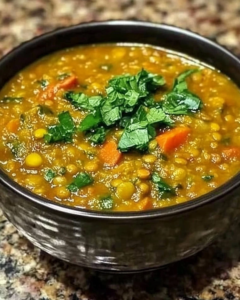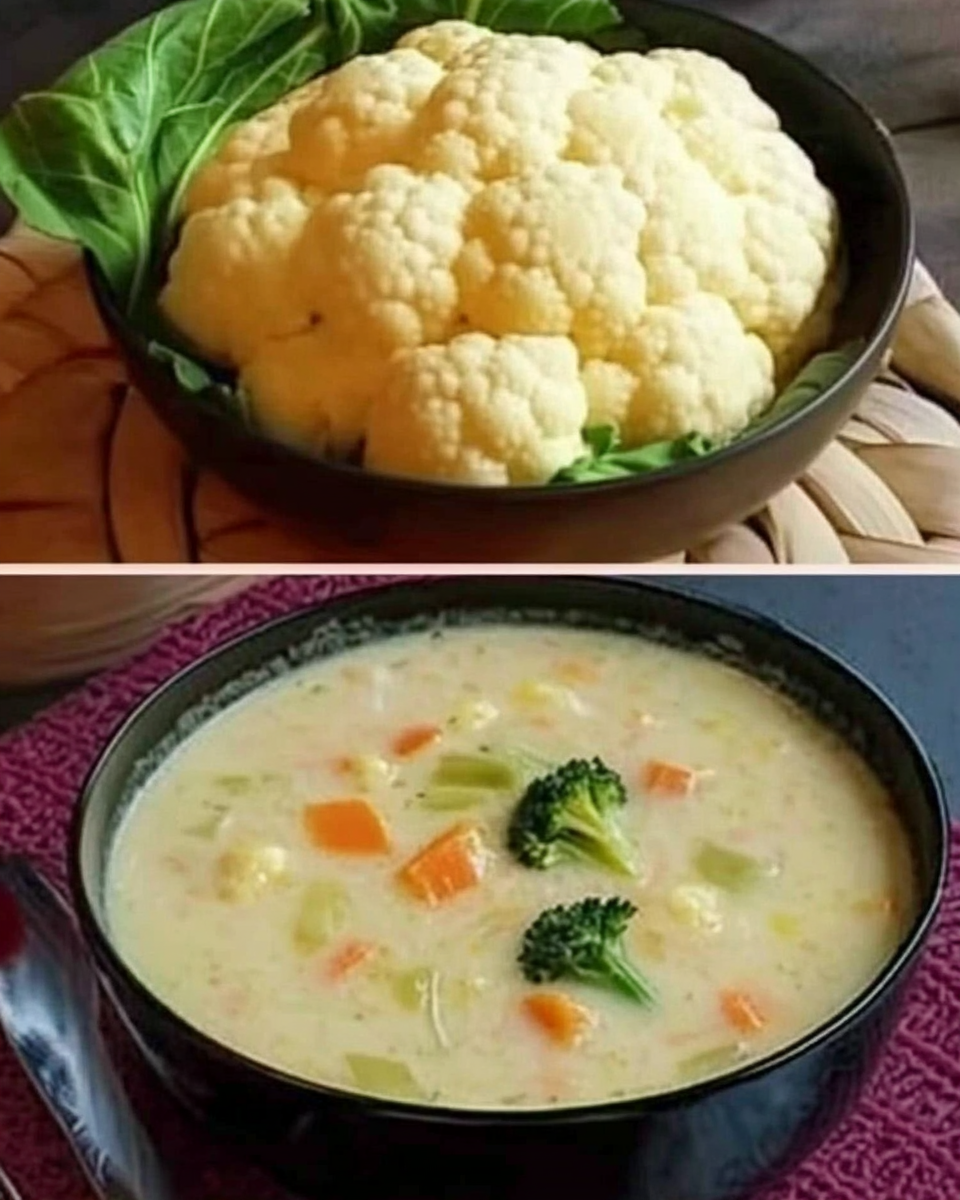INTRODUCTION
Turmeric Ginger Lentil Soup isn’t just a warm bowl of goodness—it’s a piece of my heart poured into a pot. My name’s Maggie Rae Donovan, and I’m a 42-year-old home cook living just outside of Asheville, North Carolina. No, I’m not a trained chef. I didn’t study at Le Cordon Bleu or work the line in a Manhattan kitchen. I learned everything I know the Southern way—by doing, by tasting, and by learning from the hands that came before mine.
My earliest memory of soup isn’t turmeric or lentils. It was my grandma’s Sunday chicken broth bubbling away while biscuits baked in the oven. I was six, standing on a chair, watching her move in rhythm with the ladle. That was the first time I realized food had a soul. Later in life, as I moved from town to town and raised two beautiful daughters, I always came back to the kitchen. It was my constant.
Now, let me tell you about this Turmeric Ginger Lentil Soup. It came together in my kitchen after a long shift at the hospital. I was tired, it was raining, and I needed comfort. I grabbed some red lentils, the last knob of ginger from the fridge, and that golden turmeric from the back of the spice rack. What simmered on the stove wasn’t just a soup. It was a hug in a bowl. Hearty, healing, vibrant, and just a little spicy—just like the Southern women who raised me.
If you’re looking for a cozy meal with deep flavor, a touch of spice, and a big dose of nourishment, this one’s for you. And hey, check out this cozy Veggie Soup with Herbs & Peas that I often pair with lentil dishes: Looking for inspiration? Try this heartwarming recipe.
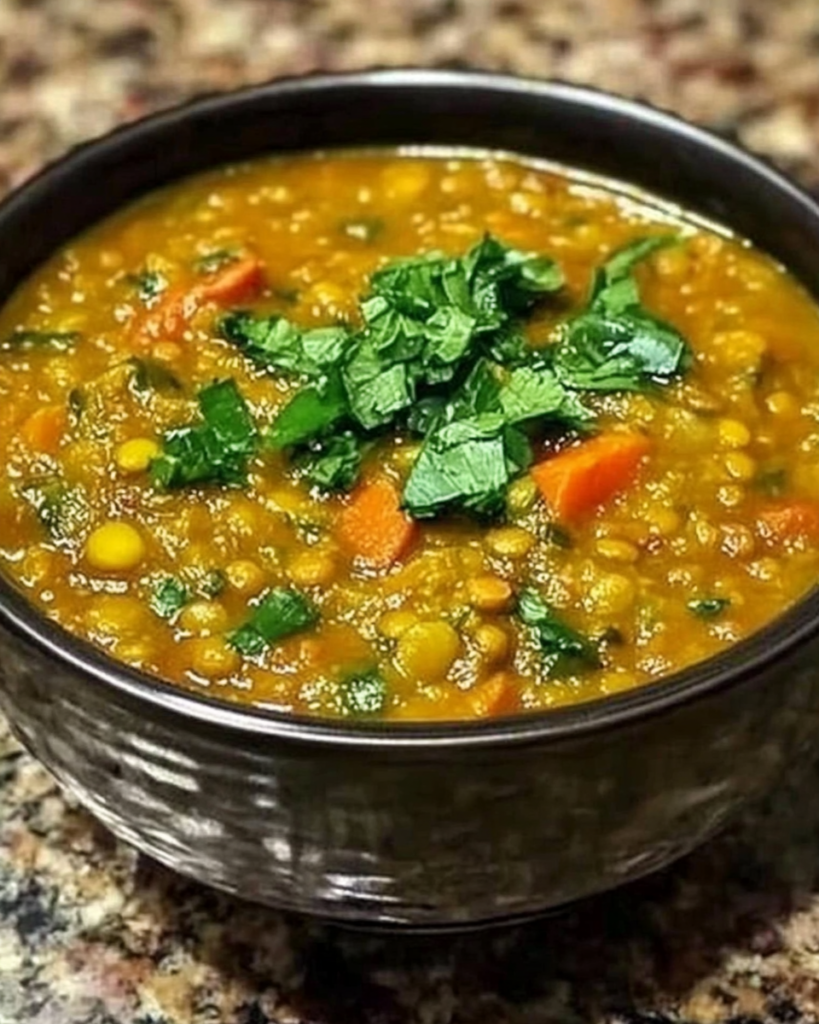
Table of Contents
The Origins and Benefits of Turmeric Ginger Lentil Soup
A Historical Look at Turmeric and Lentils in Traditional Cooking
Turmeric has been treasured for centuries in Ayurvedic and Asian cuisines for its anti-inflammatory powers. Lentils, on the other hand, are among the oldest cultivated legumes and have long symbolized nourishment and prosperity.
Ginger and Turmeric: More Than Just Spice
Both bring warmth and healing properties. Ginger soothes digestion. Turmeric fights inflammation. Together, they elevate the humble lentil soup from simple to spectacular.
Nutritional Value and Health Benefits of Turmeric Ginger Lentil Soup
Lentils: The Unsung Superfood in Your Pantry
Lentils may look small and unassuming, but they’re nutrition powerhouses that deserve a front-row spot in your kitchen. One of the best reasons I turn to lentils again and again is their ability to stretch a meal without sacrificing nutrition or taste. Each bowl of Turmeric Ginger Lentil Soup offers a rich source of plant-based protein, making it perfect for vegetarians, vegans, or anyone just wanting to cut down on meat without feeling deprived.
A single serving of lentils gives you nearly 18 grams of protein and 15 grams of fiber, helping you feel full longer while keeping blood sugar stable. They’re naturally low in fat, yet high in iron, folate, and magnesium. Lentils also support heart health and digestion thanks to their soluble fiber. That’s a lot of bang for your buck from one humble legume.
I remember a time when I had only lentils, carrots, and a bit of garlic in my pantry during a rough month financially. That pot of soup got us through more nights than I can count, and we still enjoyed it every single time. It’s the kind of food that makes you feel taken care of, both physically and emotionally.
The Healing Duo: Turmeric and Ginger for Body and Soul
Turmeric and ginger aren’t just buzzwords tossed around in wellness circles. These roots have been staples in Ayurvedic and Eastern medicine for thousands of years, and with good reason. When you combine the two in a steaming bowl of lentil soup, you’re not just cooking dinner. You’re feeding your immune system, soothing inflammation, and giving your body a little reset.
Turmeric contains curcumin, a compound known for its anti-inflammatory and antioxidant effects. It’s been studied for helping with arthritis pain, heart health, and even brain function. When paired with black pepper, curcumin’s absorption increases dramatically. That’s why you’ll always see me add a pinch of pepper in my turmeric recipes.
Ginger, on the other hand, adds both flavor and gut-friendly benefits. It soothes nausea, calms digestion, and has antimicrobial properties. It’s a natural way to fight off colds or ease tummy troubles, especially during colder months. I often toss in a few extra slices when someone in the house is feeling under the weather.
And let me tell you, nothing feels more healing than sitting down with a bowl of this soup on a quiet Sunday afternoon, windows fogged up from the steam, with the smell of turmeric and ginger filling the kitchen. It’s comfort that goes beyond taste. It’s nourishment from the inside out.
More Than a Trend: Everyday Healing Through Food
You don’t need a fancy wellness plan or pricey supplements to eat well. This Turmeric Ginger Lentil Soup proves that healing and nourishment can start in a single pot with ingredients you probably already have. In fact, turmeric and ginger are pantry staples I make sure to never run out of. They’ve helped me stay healthy during flu seasons and lifted my spirits on sluggish days.
One of my favorite parts about cooking with these roots is knowing I’m passing down real food wisdom to my daughters. I show them that what we cook matters, not just because of how it tastes, but because of what it does for our bodies.
Discover great ideas like this comforting Coconut Milk Beef Curry when you’re looking for something rich and soul-satisfying: Check out this delicious curry.
Choosing the Right Ingredients for a Flavor-Packed Turmeric Ginger Lentil Soup
Red, Brown, or Green? Picking the Perfect Lentils
Let’s talk lentils. Not all are created equal, especially when it comes to soup. For this Turmeric Ginger Lentil Soup, I reach for red lentils almost every time. They’re mild in flavor and break down beautifully as they simmer, creating a naturally creamy texture without needing any dairy or thickening agents. That smooth consistency is what gives this soup its signature hug-in-a-bowl quality.
Brown or green lentils, while still delicious, tend to hold their shape and offer a more toothsome bite. They’re great in salads or stews where you want texture. But when I want that velvety spoonful that tastes like it’s been simmering for hours, red lentils are my go-to.
There was a time I mistakenly used black beluga lentils in this recipe. The taste was fine, but the result was more stew than soup. The rich broth got lost, and I missed the silky comfort that red lentils bring. So trust me, red is best here.
Why Fresh Ginger and Turmeric Make All the Difference
You can absolutely use powdered turmeric and ground ginger in a pinch. I’ve done it, especially when the weather’s bad or the grocery list is already too long. But when you have the chance, fresh is magic. It gives this soup a brightness and aroma that dried spices just can’t fully match.
Grating fresh ginger into the pot adds a spicy zing that wakes everything up. Fresh turmeric gives the soup a rich, golden color and an earthy, almost citrusy flavor. I wear gloves when handling turmeric because it stains, but it’s worth every bit of cleanup for that depth of flavor.
Want to know a trick? Peel ginger with the edge of a spoon. It’s faster, safer, and keeps waste to a minimum. That little tip alone changed how often I use fresh ginger in my cooking.
When I shared this recipe at a neighborhood soup potluck last fall, someone asked what gave it that “unexpected spark.” The answer? A big, generous tablespoon of freshly grated ginger and turmeric. That combo is what makes this soup sing.
The Stock That Builds the Backbone
Stock is the unsung hero in most soups, and in this one, it absolutely matters. I like to use homemade vegetable stock when I have it on hand. It keeps things light and lets the spices shine. But a good quality store-bought broth will work just fine—just make sure it’s low-sodium so you can control the salt levels yourself.
If you’re not vegetarian, chicken stock adds a wonderful richness that complements the earthiness of the lentils. And if you ever make a batch from scratch, freeze it in two-cup portions. Future-you will thank you.
Coconut Milk: The Creamy Secret Weapon
Here’s where things get cozy. Stirring in a can of full-fat coconut milk takes this soup from nourishing to indulgent. The fat balances the spices, mellows the ginger’s heat, and gives the soup that silky mouthfeel that keeps you going back for one more spoonful.
I once swapped the coconut milk for almond milk in a pinch, and while the soup was still good, it didn’t have the same lush body. Stick to coconut milk if you can.
This is the part of the recipe where my daughters always peek their heads into the kitchen. “Mom, is it that yellow soup with the creamy stuff?” they ask. They know what’s coming. It’s their favorite.
Learn more about making other rustic Southern traditions come alive with this Italian Lemon Jam twist: Don’t miss this zesty tradition.
Crafting the Perfect Soup Base for Turmeric Ginger Lentil Soup

Building Flavor from the First Sizzle: The Aromatics
Every great soup starts with a base, and Turmeric Ginger Lentil Soup is no exception. This is where the magic begins, where flavor gets built layer by layer. I always start with a glug of olive oil in a heavy-bottomed pot—cast iron if I’m feeling nostalgic—and let it heat just until shimmering.
Next, I toss in chopped yellow onion, garlic, and celery. The smell alone is enough to turn heads in my house. Onions bring sweetness, garlic gives it punch, and celery adds an herbal depth that’s subtle but important. Sautéing these together for 5 to 7 minutes, until they’re soft and just starting to caramelize, is where the flavor takes root.
I call this the “sizzle and stir” stage. It’s when the soup starts to speak.
At this point, I add the freshly grated ginger and turmeric. The aroma is something you don’t forget—bright, earthy, spicy, and healing all at once. Stirring them into the base wakes up their essential oils, releasing flavor that dried powders just can’t match. This step is what sets this soup apart from any regular lentil recipe.
There was a snowy day in Asheville a few years back when I was snowed in with just the basics. I sautéed these same aromatics and realized I didn’t even need a bunch of extras. The flavors carried the whole meal. And my house smelled like a spice shop in the best way.
Liquid Gold: Adding Stock, Tomatoes, and Coconut Milk
Once the aromatics are soft and fragrant, it’s time to pour in the liquid ingredients. Start with your broth—vegetable stock for a lighter taste, or chicken broth if you’re looking for extra richness. Use just enough to cover your lentils by about an inch. As they cook, they’ll absorb the flavor and thicken the soup naturally.
I like to stir in one can of diced tomatoes at this stage. The acidity helps balance the warmth of the ginger and turmeric. It cuts through the richness and gives the soup a layer of brightness that surprises people. Even folks who claim not to like tomatoes always finish their bowl.
Now, here’s my favorite part. About halfway through cooking, I add a can of full-fat coconut milk. It melts into the pot like cream in coffee, giving the soup that luxurious texture we all love. It also helps mellow the spices just enough, especially if you’re serving kids or spice-sensitive eaters.
Let everything simmer together for at least 30 minutes. The red lentils will break down, the flavors will deepen, and the soup will transform into something that feels like it’s been cooking all day—even if it hasn’t.
I remember serving this soup at a church luncheon, and one woman asked if it had been slow-cooked overnight. I smiled and said, “Nope, just a good sauté and a little coconut milk.”
That’s the magic of a well-built base.
Looking for inspiration? Try this mouthwatering comfort food that’s perfect for chilly days: Rich Creamy Chicken Bacon Mushroom Stroganoff
Spice It Right—Blending Herbs and Seasonings in Turmeric Ginger Lentil Soup
Essential Spices That Make This Soup Stand Out
When it comes to Turmeric Ginger Lentil Soup, the right spices don’t just season the dish—they elevate it. The key is balance. You want the earthiness of turmeric to shine, the heat of ginger to spark, and the support of warm spices to round everything out.
Here’s my go-to spice lineup that I keep stocked in a little wooden drawer next to my stovetop:
- Ground cumin – Adds a toasty, nutty base. It’s warm without being spicy and plays well with turmeric.
- Sweet paprika – Offers color and subtle sweetness that balances the stronger spices.
- Black pepper – More than just seasoning. It activates curcumin (the powerful compound in turmeric), making it more bioavailable.
- Ground coriander – Slightly citrusy and floral, it adds complexity without overwhelming the soup.
I sprinkle these in just after the aromatics have softened, toasting them briefly in the pan before adding liquid. It’s a small step with big impact. Toasting helps release the natural oils in the spices, creating a deeper, fuller flavor. Trust me, your nose will tell you when it’s just right.
When I served this soup at our last neighborhood garden party, one friend swore I must have used a secret spice mix. Nope. Just cumin, paprika, and a pinch of pepper toasted in olive oil until fragrant.
Turn Up the Heat or Keep It Mild: Your Choice
One of the great things about this soup is how adaptable it is to different spice tolerances. My girls like just a hint of heat, while my brother-in-law insists I crank it up. Here’s how I manage both:
- For a gentle kick: Add a pinch of red chili flakes or a tiny dash of cayenne pepper toward the end of cooking. It gives warmth without overpowering.
- For bolder heat: Use fresh minced chili or double up on the ginger. Just be sure to balance it with coconut milk for that creamy buffer.
Don’t forget a small squeeze of lemon juice at the end. It’s the final touch that brightens everything up and keeps the flavors from feeling too heavy. I call it the “sparkle” of the soup. It’s subtle but transformative.
Don’t Be Afraid to Taste and Tweak
One of the biggest lessons I’ve learned in home cooking is this: taste as you go. Spices bloom and mellow over time, so what seems strong in the beginning might soften by the end.
I always keep a little spoon nearby while simmering, tasting every 10 minutes or so. Maybe the cumin needs a boost. Maybe the ginger took over and needs some balance. That’s the beauty of soup—it forgives. It adjusts. It welcomes a little improvisation.
That’s how I stumbled upon adding a dash of cinnamon once. I was out of coriander, and cinnamon was close by. Just a pinch gave the soup a warm, almost sweet undertone that made it taste even more comforting. Now, I add it intentionally when I want that cozy twist.
Cooking Techniques for Texture and Taste in Turmeric Ginger Lentil Soup
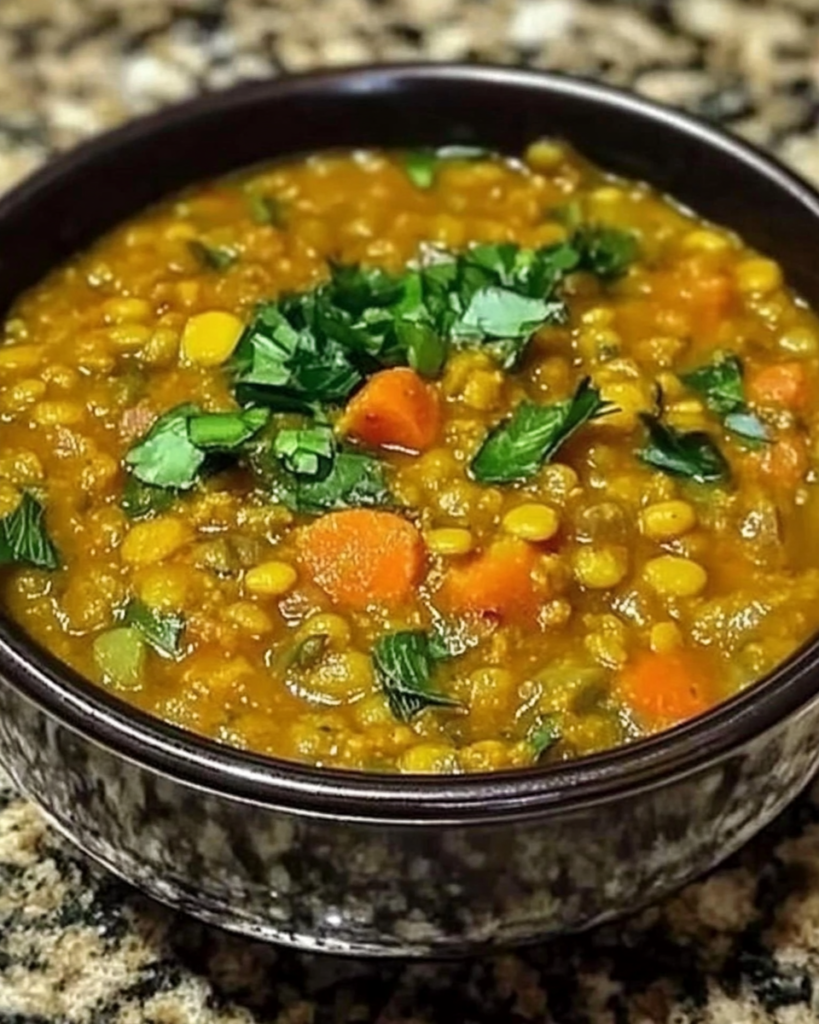
Sauté First, Simmer Second: Why Timing Matters
If there’s one golden rule in soup-making I swear by, it’s this: build your flavor before you ever add the broth. It all starts with a proper sauté. You want your onions soft, your garlic fragrant, and your ginger and turmeric sizzling gently before you even think about pouring in liquid.
I typically sauté everything in olive oil for about 10 minutes over medium heat. This gentle browning process unlocks a deep, rich base layer of flavor. Add your dry spices at the tail end of this sautéing step—this is your chance to “bloom” them, letting the heat intensify their natural oils.
It’s the kind of technique that doesn’t show off, but you’ll taste the difference in the finished soup. My daughter calls it the “magic step,” and she’s not wrong.
One rainy afternoon last fall, I skipped this part in a hurry and just dumped everything into the pot. It still tasted decent—but it lacked depth. That’s when I knew: this step’s not optional.
Let It Simmer Gently—And Know When to Stop
After sautéing, it’s time to add your lentils, broth, tomatoes, and that luxurious coconut milk. Bring it all to a gentle boil, then reduce the heat and let it simmer low and slow. The red lentils will soften and begin to break down within 25 to 30 minutes, thickening the soup naturally.
Here’s the sweet spot: You want the lentils to melt into the broth but not completely vanish. They should add body without making the soup overly mushy. Stir occasionally to prevent sticking—especially if your pot runs hot.
If you like a silkier soup (which I often do when serving it as a starter), you can give it a few pulses with an immersion blender. Just a few swirls—leave some texture behind. This trick gives the soup that creamy consistency that makes people ask, “Wait, is there cream in this?”
Sometimes I fully blend it when I want a smoother feel, especially when I’m serving it with naan or flatbread. But mostly, I go for the happy middle ground: creamy but still rustic.
Adjusting Seasoning at the End
Once the soup has simmered and thickened, it’s time to finish strong. This is where I add:
- A squeeze of lemon juice to lift the flavors
- A touch more salt or black pepper, if needed
- A few tablespoons of fresh chopped cilantro or parsley for brightness
Tasting at the end is crucial. Spices mellow over time, and coconut milk can mute salt. Don’t be afraid to adjust.
I always keep a small ramekin of flaky sea salt nearby for this final stage. Just a pinch at the end brings all the flavors forward like turning up the brightness on a photo.
And don’t forget: the soup will thicken as it cools. If you’re storing leftovers, add a splash of broth or water the next day to bring it back to life.
Discover great ideas like this satisfying slow-braised lamb dish for your next cozy dinner night: Golden-Crusted Aussie Meat Pies.
Add-Ins and Variations to Elevate Your Turmeric Ginger Lentil Soup
Boost the Nutrition and Flavor With Seasonal Veggies
One of the most beautiful things about Turmeric Ginger Lentil Soup is how adaptable it is. You can build on the base recipe with seasonal produce to match whatever’s in your fridge or farmer’s market basket. I often think of this soup as a canvas—simple, bold, and just waiting for personal touches.
Here are my favorite veggie add-ins:
- Carrots – They bring natural sweetness and pair beautifully with the earthy turmeric. Slice them thin so they soften quickly.
- Sweet Potatoes – Dice them small and toss them in with the lentils. They add creaminess and depth with just a touch of natural sugar.
- Spinach or Kale – Stir in a handful during the last 5 minutes of cooking. These greens wilt perfectly and add a lovely contrast in color and nutrition.
- Zucchini – Great for summer versions. Dice and add during the last 10 minutes of cooking to keep them tender, not mushy.
I remember one autumn when I added leftover roasted butternut squash to the soup. It was velvety and rich and gave the entire dish an almost stew-like consistency. My neighbor Liz swore it was the best version she’d ever tasted.
Adding Protein: For Bigger Appetites or Main-Course Meals
This soup is already protein-packed from the lentils, but when I’m feeding hungry teens or hosting a dinner where it’s the star of the table, I like to throw in a little extra protein.
Here are a few of my go-to options:
- Shredded Rotisserie Chicken – Stir it in just before serving. It soaks up the flavor and bulks up the meal with zero extra cooking.
- Pan-Fried Tofu – Cube and crisp tofu separately in olive oil, then stir in for a vegetarian-friendly option with great texture.
- Tempeh Crumbles – Earthy and nutty, tempeh is hearty and holds up well in the broth. I marinate it in a little soy sauce and garlic before adding.
For something even more satisfying, top the soup with a poached egg. When the yolk runs into the hot broth, it creates a creamy richness that’s unforgettable. One of my daughters calls it “magic soup night” when I make it this way.
And if you’re after something truly filling, a small scoop of cooked quinoa or brown rice stirred in turns this into a full, stick-to-your-ribs meal.
Special Touches to Make It Yours
Want to add even more flair? Here are some of my favorite little extras:
- Toasted coconut flakes for crunch and contrast
- Pumpkin seeds (pepitas) for a nutty finish
- Crumbled feta or goat cheese for creamy, tangy contrast
- A drizzle of chili oil or garlic-infused olive oil on top before serving
I love setting up a soup bar at our fall gatherings. I serve the base soup in a big pot and set out bowls of toppings and add-ins. Everyone builds their own, and it makes dinner feel like a cozy, custom experience.
Looking for inspiration? Try this creative and comforting Beef & Bell Pepper Stir Fry for a weeknight twist: Check out this savory stir fry.
Serving Suggestions and Pairings for Turmeric Ginger Lentil Soup
Bread on the Side? Always.
In my Southern kitchen, soup is never served alone. Something warm, soft, or crusty always lands on the table right beside the bowl. And Turmeric Ginger Lentil Soup, with all its creamy richness and earthy depth, deserves the right partner.
Here are a few of my favorite bread pairings:
- Crusty Artisan Bread – Think sourdough or rustic French loaves. Perfect for dunking and soaking up the golden broth.
- Homemade Cornbread – Adds a subtle sweetness that plays beautifully with the spices. Bonus points if it’s made in a cast iron skillet.
- Garlic Naan or Flatbread – A nod to the soup’s Indian-inspired roots. It’s buttery, chewy, and ideal for scooping.
- Savory Muffins – Like a cheddar-chive muffin or a bacon-stuffed biscuit. It’s a Southern twist that makes every spoonful even cozier.
There was a potluck in our church hall last year where I served this soup alongside warm rosemary focaccia. Folks went wild over the combo. One lady even said, “I’d eat cardboard if it was dipped in that soup.” Safe to say, the bread matters.
Garnishes That Add That Final Spark
You know how a good outfit feels more complete with the right accessories? That’s how I think about garnishing soup. It’s not just pretty—it’s flavorful and functional.
These are my go-to garnishes for Turmeric Ginger Lentil Soup:
- Swirl of Coconut Milk or Greek Yogurt – Adds creaminess and visual appeal. I love using the back of a spoon to make a little swirl right before serving.
- Fresh Chopped Cilantro or Parsley – Brings a burst of green and a fresh contrast to the warm spices.
- Lemon Wedges on the Side – A final squeeze of lemon brightens the dish and lifts all the flavors.
- Toasted Seeds or Nuts – Pepitas, sunflower seeds, or crushed cashews add a crunchy contrast that surprises people in the best way.
Once, I brought this soup to a neighborhood brunch and added a dollop of spiced yogurt mixed with cumin and garlic. People asked if it was a secret sauce. Nope, just yogurt. Sometimes the little things really make the biggest impact.
Soup Pairings for a Full Table
Want to build a full meal around this soup? Here are a few great pairings:
| Dish | Why It Works |
|---|---|
| Simple Green Salad with Lemon Vinaigrette | Light and fresh, it balances the soup’s warmth. |
| Roasted Cauliflower with Za’atar | Adds texture and complements the Middle Eastern spices. |
| Spiced Chickpea Fritters | Crispy and protein-packed, perfect for dipping. |
| Crispy Halloumi or Paneer Bites | A satisfying side that adds savory, cheesy notes. |
If you’re feeling bold, try pairing it with a chilled glass of ginger-lime spritzer or turmeric tonic. It’s like a spa day in soup form.
Check out this savory lamb chop dinner if you’re looking to go even heartier for your next gathering: Don’t miss this Mediterranean-style favorite.
Storage, Freezing, and Reheating Tips for Turmeric Ginger Lentil Soup
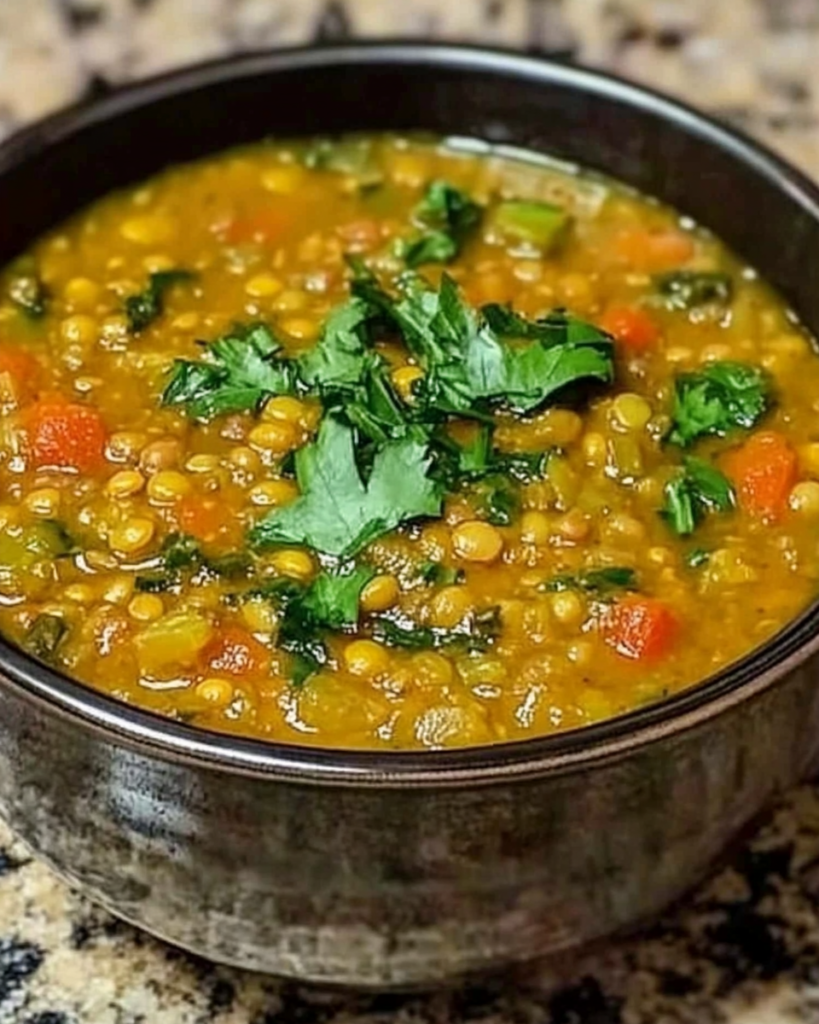
PART 9: Storage, Freezing, and Reheating Tips for Turmeric Ginger Lentil Soup
How Long Does It Last in the Fridge?
Once your Turmeric Ginger Lentil Soup is done simmering and you’ve licked the ladle clean (no shame here), the good news is it keeps like a dream. In fact, the flavors deepen and mellow overnight, making leftovers even better.
- Refrigerator Storage: Store in an airtight glass or BPA-free plastic container for up to 5 days. Let the soup cool completely before refrigerating to prevent condensation and spoilage.
- Best Practices: I like to portion it out into individual servings, so it’s easy to grab-and-go for lunch or a quick weeknight meal. Labeling containers with dates is a good habit that my nurse brain insists on!
I once made a double batch before a storm rolled through Asheville, thinking we’d be stuck inside for a few days. We were, and that soup got us through it with warm bellies and no complaints.
Can You Freeze It? Absolutely.
Yes, yes, yes—you can freeze Turmeric Ginger Lentil Soup, and you should! It freezes like a champ and is perfect for batch cooking.
- Freezing Tips:
- Let the soup cool completely.
- Divide into freezer-safe containers or heavy-duty zip-top bags.
- Lay bags flat to save space and label with the date.
- Soup stays good in the freezer for up to 3 months.
Heads-up: The coconut milk may slightly separate when thawed, but a quick stir while reheating will bring everything back together.
I keep a stash of this soup in my freezer almost year-round. It’s my go-to when I’m under the weather, running late, or just don’t feel like cooking from scratch.
Reheating Without Losing Flavor or Texture
Reheating soup should never mean sacrificing taste or turning it into mush. Here’s how I do it:
- From the Fridge: Pour into a pot and heat over medium-low. Add a splash of water or broth if it’s too thick. Stir gently until hot.
- From the Freezer: Thaw overnight in the fridge, or reheat from frozen by gently warming in a pot with a bit of extra broth.
- Microwave Option: Use a microwave-safe bowl, cover with a lid or plate (to prevent splatter), and heat in 1-minute intervals, stirring between each round.
And don’t forget the garnishes! Even reheated, a swirl of coconut milk, a squeeze of lemon, or a sprinkle of fresh herbs can make leftovers feel brand new.
Make It a Meal Prep Staple
If you’re into meal planning, this soup is a star. Here’s how I batch it:
| Step | Tip |
|---|---|
| Cook double the recipe | It doesn’t take twice the time. |
| Freeze half | For a rainy day or lazy Sunday. |
| Keep a fridge jar | For quick lunches throughout the week. |
There’s something satisfying about knowing a healthy, comforting meal is just minutes away. It’s like giving your future self a hug.
Looking for more freezer-friendly inspiration? Try these crispy lamb shanks you can prep ahead: Check out this hearty red wine-braised recipe.
Turmeric Ginger Lentil Soup – Your Top Questions Answered
Does turmeric go well in lentil soup?
Absolutely. Turmeric is a natural match for lentils. Its earthy, slightly bitter flavor brings out the best in the legumes, while its golden color adds vibrance to your bowl. Combined with ginger and spices like cumin or paprika, it adds depth without overpowering the dish. If you’re new to turmeric, start small and build—½ teaspoon goes a long way.
When I first experimented with turmeric in soup, I was skeptical. But after tasting the warm, comforting richness it added, I was hooked. Now, I don’t make lentil soup without it.
What can I add to my lentil soup to make it taste better?
The secret to better lentil soup lies in layering flavor:
Sauté aromatics like onion, garlic, ginger, and celery before adding broth.
Toast your spices (turmeric, cumin, paprika) to release their oils.
Use vegetable or chicken stock instead of plain water.
Add acidity with lemon juice or tomatoes for brightness.
Finish with garnishes like fresh herbs, yogurt, or chili oil.
If your soup tastes flat, it probably needs salt, acid, or spice. Taste, adjust, and taste again—that’s how good soup is made.
Why put turmeric in soup?
Turmeric brings more than just flavor. It’s a nutritional powerhouse:
Anti-inflammatory: Contains curcumin, known to reduce joint pain and inflammation.
Antioxidant: Supports immune function and protects cells from damage.
Digestive aid: Helps with bloating and gut health.
Natural color: Adds a vibrant golden hue that makes every spoonful look as good as it tastes.
Plus, paired with ginger, it turns a basic soup into a nourishing bowl of wellness—especially on chilly days or when you’re under the weather.
Is lentil soup really good for you?
Yes, it’s one of the healthiest and most satisfying meals you can make. Here’s why:
Nutrient
Benefit
Protein
Red lentils pack plant-based protein to keep you full.
Fiber
Supports digestion and keeps blood sugar stable.
Iron
Boosts energy and prevents fatigue.
Low in fat
Especially when made with veggie broth and coconut milk.
Rich in vitamins
Especially B vitamins and magnesium.
This soup nourishes without being heavy. It’s perfect for meatless Mondays, detox days, or when you just want a wholesome, warming meal.
Don’t miss our flavor-packed stir-fry if you’re craving something fast and satisfying: Check out this garlic soy beef bowl.
